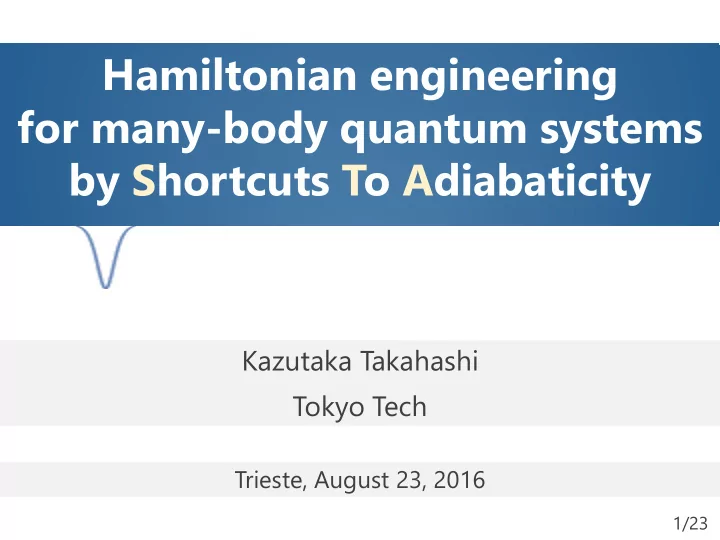

Hamiltonian engineering for many-body quantum systems by Shortcuts To Adiabaticity Kazutaka Takahashi Tokyo Tech Trieste, August 23, 2016 01/23
Motivation: QA Target Hamiltonian Best driver Hamiltonian? Best schedule? ► Hamiltonian engineering ► Need a principle ► Systematic, easy to implement
Shortcuts to Adiabaticity Tracking adiabatic passage of reference H Demirplak Rice 2003 2005 Berry 2009 Chen Ruschhaupt Schmidt del Campo Guéry-Odelin Muga 2010 Red: without STA Black: with STA Blue: fidelity Slow Fast Adiabatic Nonadiabatic
Aim Use of STA for Hamiltonian Engineering Inverse Engineering / Counterdiabatic Driving for Many-body Spin Systems Principle: ► Fundamental equation for QM ► 3 meanings
Result 1 1.0 T=1 Linear schedule T=2 n z T=5 T=10 T=20 T=50 T=100 0.5 0.5 1.0 0.0 t/T Inverse Engineering 1.0 T=1.0 T=2.0 n z T=5.0 3.0 2.0 T=10.0 T=0.8 f T=1.0 Γ T=2.0 T=5.0 2.0 0.5 T=10.0 1.0 1.0 T=0.8 T=1.0 T=2.0 T=5.0 T=10.0 0.0 0.5 1.0 0.5 1.0 0.0 0.0 0.5 1.0 t/T t/T t/T
Result 2 Counterdiabatic Driving N=3 Infinite system: Soliton
Shortcuts to Adiabaticity 07/23
Equation of Motion von Neumann equation ► Equation for density operator ► Equivalent to Schrödinger eq. ► ρ obtained for a given H (and initial state)
Dynamical Invariant Lewis Riesenfeld 1969 Time independent Eigenstates of F ► Solution of Schrödinger eq = Adiabatic state of F (not of H!) ► Time evolution described by eigenvalue eq.
Shortcuts to Adiabaticity Had Hcd Eigenstates of F Counterdiabatic Driving - Had = Target H ≠ Total H - Hcd: Assist term for a given Had - State follows an adiabatic passage of Had, not of H Inverse Engineering - Total H = Target H - F engineered to design H - State follows an adiabatic passage of F, not of H
How to Solve? Reduction to Simple Systems - Mean-field approximation - Reduction of Hilbert space Use of Classical Nonlinear Systems Okuyama and KT 2016 - Quantum STA is equivalent to Classical nonlinear integrable systems - Integrability: existence of dynamical invariant
Inverse Engineering of Transverse-field Ising Model 12/23
Mean-field Solution Mean field ► F solved by mean-field ansatz ► Effective 1-body 2-level system ► Solutions characterized by Bloch vector n (t)
Inverse Engineering ► Schedule determined by Bloch vector ► Initial and final conditions fixed ► No need to solve differential equations z F H 0 y x ► Follow adiabatic passage of F, not of H
Results ► Interpolating boundary conditions Schedule 1 Schedule 2 ► Non-unique schedule 2 6 Γ 3 T=0.5 T=0.5 T=0.8 f f T=1.0 T=1.0 Γ T=1.0 3 T=2.0 T=2.0 T=2.0 T=5.0 T=5.0 T=5.0 4 T=10.0 2 2 1 2 1 T=0.8 1 T=1.0 T=2.0 T=5.0 T=10.0 0 0 0 0 0 0.2 0.4 0.6 0.8 1 t/T t/T 0 0.2 0.4 0.6 0.8 1 0 0.2 0.4 t/T 0.6 0.8 1 0 0.2 0.4 0.6 0.8 1 t/T 1 1 T=1.0 T=1.0 n z n z T=2.0 T=2.0 T=5.0 T=5.0 0.8 0.8 T=10.0 0.6 0.6 0.4 0.4 0.2 0.2 0 0 0 0.2 0.4 0.6 0.8 1 0 0.2 0.4 0.6 0.8 1 t/T t/T
Generalization How about Non-MF Hamiltonian? ► Mean-field approximation ► Local manipulation required ► Solvable for Mattis model (No Frustration): No need to know ξi
From Classical Nonlinear Integrable Systems to Quantum Shortcuts to Adiabaticity 17/23
Lax Formalism Lax equation Lax 1968 Lax pair ► Expression of integrability ► Time-independent eigenvalues of L: Infinite conserved quantities ► KdV, Toda, Sine-Gordon, Nonlinear Schrödinger, … Classical Nonlinear Quantum Dynamics Dynamics
KdV Equation ► Particle transported by multi-soliton potentials
Toda Equation in XY Spin Chain Toda Equations ► Lax pair in tri-diagonalized form ► Gauge transformation in a more convenient form ► Equivalent to free fermion
Solutions of Toda Equation: Finite Systems N=3 ► Continuous deformation from XY to noninteracting H ► Isospectral deformation
Solutions of Toda Equation: Infinite Systems Single soliton Double solitons ► Local manipulation of coupling functions ► Flipped-spin transferred by solitons
Summary Time evolution of quantum state Dynamical Invariant: Basis for STA Integrability for classical nonlinear systems ► States follow an adiabatic passage of a reference H ► Importance of local manipulations KT, Inverse engineering for many-body spin systems , To appear soon… M Okuyama and KT, From Classical Nonlinear Integrable Systems to Quantum Shortcuts to Adiabaticity , PRL 117, 070401 (2016) 23/23
Recommend
More recommend